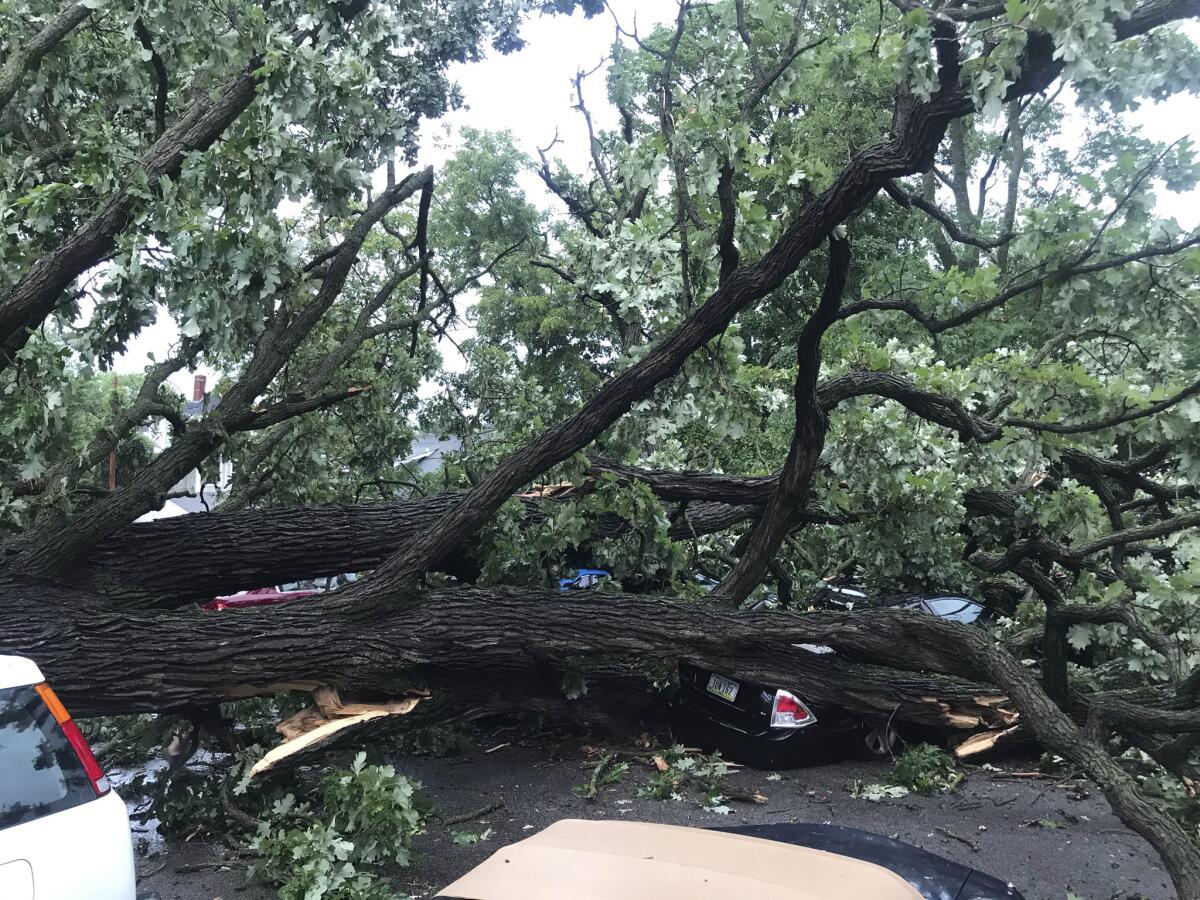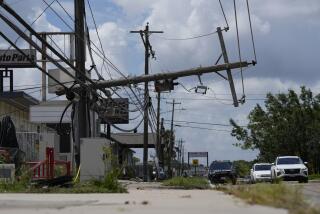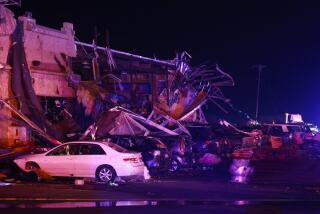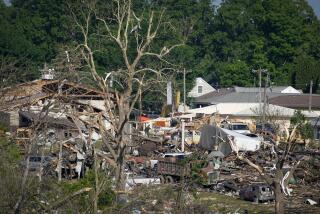Powerful derecho leaves path of devastation across Midwest

IOWA CITY, Iowa â A rare storm packing 100-mph winds and with power similar to an inland hurricane swept across the Midwest on Monday, blowing over trees, flipping vehicles, causing widespread property damage and leaving hundreds of thousands without power as it moved through Chicago and into Indiana and Michigan.
The storm, known as a derecho, lasted several hours as it tore from eastern Nebraska across Iowa and parts of Wisconsin and Illinois. It had the wind speed of a major hurricane and likely caused more widespread damage than a normal tornado, said Patrick Marsh, science support chief at the National Weather Serviceâs Storm Prediction Center in Norman, Okla.
In northern Illinois, the National Weather Service reported a wind gust of 92 mph near Dixon, about 100 miles west of Chicago, and the storm left downed trees and power lines that blocked roadways in Chicago and its suburbs. After leaving Chicago, the most potent part of the storm system moved over north central Indiana by late afternoon.
âThe storm system as a whole is definitely beginning its decay,â said Northern Illinois University meteorology professor Victor Gensini.
A derecho is not quite a hurricane. It has no eye, and its winds come across in a line. But the damage it is likely to spread over such a large area is more like an inland hurricane than a quick, more powerful tornado, Marsh said. He compared it to the devastating Super Derecho of 2009, which was one of the strongest on record. It traveled more than 1,000 miles in 24 hours, causing $500 million in damage, widespread power outages and the deaths of a handful of people.
âThis is our version of a hurricane,â Gensini said in an interview from his home about 15 minutes before the storm was about to hit. Minutes later he headed to his basement for safety as the storm took aim at Chicago, starting with its suburbs.
Gensini said this derecho will go down as one of the strongest in recent history and be one of the nationâs worst weather events of 2020.
âIt ramped up pretty quickâ around 7 a.m. Central time in eastern Nebraska. âI donât think anybody expected widespread winds approaching 100, 110 mph,â Marsh said.
Several people were injured and widespread property damage was reported in Marshall County in central Iowa after 100-mph winds swept through the area, said emergency management coordinator Kim Elder.
She said the winds blew over trees, ripped road signs out of the ground and tore roofs off of buildings.
âWe had quite a few people trapped in buildings and cars,â she said. She said the extent of injuries is unknown and that no fatalities have been reported.
Elder said some people reported their cars flipping over from the wind, having power lines fall on them and getting injured when hit by flying debris. Dozens of cars at one factory had their windshields blown out. Buildings have also caught on fire, she said.
âWeâre in life-saving mode right now,â Elder said.
Marshalltown Mayor Joel Greer declared a civil emergency, telling residents to stay home and off the streets so that first responders can respond to calls.
MidAmerican Energy said nearly 101,000 customers in the Des Moines area were without power after the storm moved through the area. Reports from spotters filed with the National Weather Service in Des Moines had winds in excess of 70 mph.
Roof damage to homes and buildings was reported in several Iowa cities, including the roof of a hockey arena in Des Moines.
Across the state, large trees fell on cars and houses. Some semi-trailers flipped over or were blown off highways.
Farmers reported that some grain bins were destroyed and fields were flattened, but the extent of damage to Iowaâs agriculture industry wasnât immediately clear.
MidAmerican spokeswoman Tina Hoffman said downed trees are making it difficult in some locations for workers to get to the power lines. In some cases, power line poles were snapped off.
âItâs a lot of tree damage. Very high winds. It will be a significant effort to get through it all and get everybody back on,â she said. âIt was a big front that went all the way through the state.â
Cedar Rapids, Iowa, has âboth significant and widespread damage throughout the city,â said public safety spokesman Greg Buelow.
âWe have damage to homes and businesses, including siding and roofs damaged,â he said. âTrees and power lines are down throughout the entire city.â
Buelow said residents should stay home so crews can respond to âpotentially life-threatening calls.â Tens of thousands of people in the metro area were without power.
What makes a derecho worse than a tornado is how long it can hover over one place and how large an area the high winds hit, Marsh said. He said winds of 80 mph or even 100 mph can stretch for â20, 30, 40 or God forbid 100 miles.â
âRight now, itâs making a beeline for Chicago,â Marsh said Monday mid-afternoon. âWhether or not it will hold its intensity as it reaches Chicago remains to be seen.â
But the environmental conditions between the storm and Chicago are the type that wonât likely diminish the storm, Marsh said. It will likely dissipate over central or eastern Indiana, he said.
What happened is unstable super-moist air has parked over the northern plains for days on end, and it finally ramped up Monday morning into a derecho.
âThey are basically self-sustaining amoebas of thunderstorms,â Gensini said. âOnce they get going like they did across Iowa, itâs really hard to stop these suckers.â
Derechos, with winds of at least 58 mph, occur about once a year in the Midwest.
The storms raced over parts of eastern Nebraska before 9 a.m. Monday, dropping heavy rains and high winds. Strong straight-line winds pushed south into areas that include Lincoln and Omaha, National Weather Service meteorologist Brian Barjenbruch said.
âOnce that rain-cooled air hit the ground, it surged over 100 miles, sending incredibly strong winds over the area,â Barjenbruch said.
Omaha Public Power District reported more than 55,500 customers without power in Omaha and surrounding communities.
The weather serviceâs Marsh said thereâs a huge concern about power outages that will be widespread across several states and long lasting. Add high heat, people with medical conditions that require power and the pandemic, âit becomes dire pretty quickly.â
More to Read
Sign up for Essential California
The most important California stories and recommendations in your inbox every morning.
You may occasionally receive promotional content from the Los Angeles Times.










